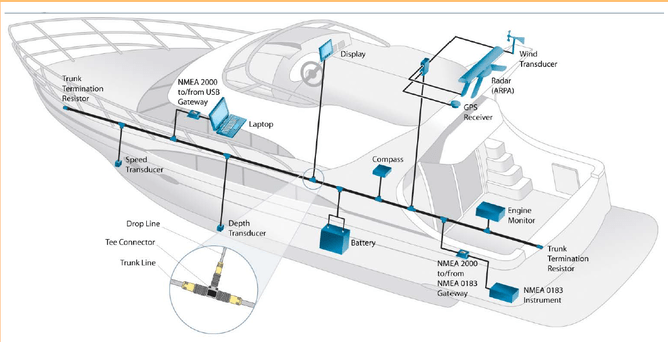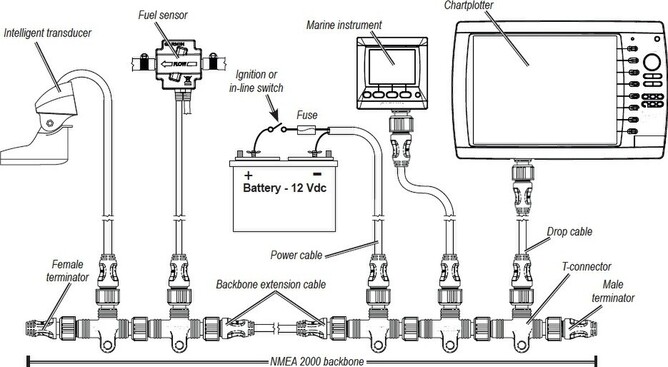NMEA2000 is a common language which is used by a number of manufacturers to communicate various bits of data between units. You can do some amazing things with NMEA2000, and the best part is that putting together a system is as easy as playing with lego.
What is NMEA2000?
NMEA2000 is the marine version of CANBUS, the same system which is used in your car to control things like air-conditioning or the GPS. In marine format, it usually has standardised connectors, and generally uses standard sentences, allowing you to connect different brand name sensors and displays. For most of what we do, the display used is the boats chartplotter, which is well set up to co ordinate and display complex information, and the sensors are GPS, wind, tanks and engine information.
Why use NMEA2000?
Because NMEA2000 is a standardised system, expansion or changing the system is extremely easy. For example, if you have a wind sensor on the top of the mast with a display in the cockpit, previously if someone damaged the display, and the unit was a couple of years old, you would usually need to swap both the display and wind vane, including re running the cable down the mast. With a NMEA2000 system, you can swap or change either end, or add another display elsewhere if you wished, or add another sensor (eg depth or tank level). You could add a transmitter to receive the information on a watch, or send it over a cellular connection to a remote computer. The system is much more flexible, and will help future proof your installation.
What brands can I interconnect?
The big four manufacturers, Furuno, Garmin, Navico (Simrad/Lowrance) and Raymarine all have NMEA2000 network capability. Furuno, Garmin and Navico (although not some Simrad) equipment all uses the same connectors, often called Micro, or Micro C connectors. Raymarine uses it’s own connectors and calls the system SeaTalk NG, but with an adapter cable, or some enthusiasm and a soldering iron it can be connected to a micro C network.
There is also various auxiliary equipment manufacturers which use NMEA2000 as their main source of communication, such as Fusion Stereos, Maretron, BEP C-Zone and Actisense. Care should be taken when connecting your chartplotter to these units, as some data and control might not work!
Connecting Engines
Engine systems also use NMEA2000, with most outboard manufacturers either selling adapters, or having direct connection to Micro C available at the engine. If using a Mercury or Yamaha Command link outboards then a gateway box needs to be bought instead of an adapter plug, which does add cost.
Diesel engines will often use J1939 CANBUS, which is similar, but not the same as NMEA2000. Maretron make an excellent product for reading this information to a NMEA2000 network.
For engines that are too old or too cheap to have NMEA2000 connectivity, NMEA2000 fuel flow sensors are available, which when connected to a chartplotter will give you economy and range data.
What bits of information is common to add to a NMEA2000 network?
The most common information we set up on NMEA2000 networks is GPS information. For Garmin, Furuno and Simrad, this is the default way of getting GPS information into a chartplotter on networked systems, which is great because if you have a chartplotter, then you’ll also have a basic NMEA200 network already onboard. Mostly we connect engines up to chartplotters to display stuff like fuel usage (and so economy) RPM, Hours etc. We also do a number of NMEA2000 wind sensors and fuel flow sensors. Fusion Stereo connectability (called Fusion link) works really well with a good range of chartplotters.
What else can I can do with NMEA2000
Recently we set up the biggest NMEA2000 network we have ever done. It was a combined Garmin / Furuno / Maretron network and featured some impressive features:
- Text message alerts – Amongst literally hundreds of other items it monitored, the Maretron system monitors fire system, bilge levels, battery levels, shore power levels and sends a text message when any of these are out of a particular range. It can also send an email as well.
- Remote Ipad monitoring. The entire system could also be monitored by ipad, from anywhere with an internet connection. This means that maintenance managers and engineers can monitor the vessel while it is still in use, cutting the trouble shooting time
- Vessel parameter storage – Every single piece of information passed on the network is stored on a USB stick, so long term trends can be tracked by comparing current performance with previous performance and if an incident occurs, every action is recorded.
More Information on how to put together a NMEA2000 network



